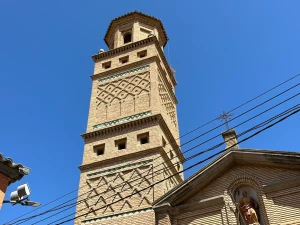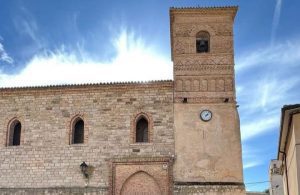
Circular from
the country school
The “Circular from the rural school” project is a cooperation project between rural development groups led by the Asociación Territorio Mudéjar.
The following have participated in the project: ADRI Calatayud-Aranda, ADRI Jiloca-Gallocanta, FEDIVALCA -Valdejalón and Campo de Cariñena-, ASOMO Tarazona and el Moncayo, CEDEMAR -Bajo Aragón Caspe and Ribera Baja del Ebro-, ADRAE -Ribera Alta del Ebro- and ADEFO Cinco Villas.
The objective is to develop educational materials around the Mudejar identity of the towns, placing rural schools and the educational community of the towns as the center of the project.
Based on the work developed, for almost three years, the students of fifteen schools have designed a walk through their town in which we can learn about the main points of interest and their connection with the Mudejar culture.

Alpartir
This walk shows us the work of the pupils of the Ramón y Cajal school in Alpartir.
In the case of Alpartir, there is no Mudejar monument but there is an evident Islamic heritage that we will interpret in this tour around the town, discovering its urban planning of Islamic tradition, its marked agricultural landscape and some spaces that could have been workplaces, such as the workshops.

1. History of the town
Alpartir, in medieval times, was under the power of the military order of the Hospital (Order of St. John of Jerusalem) like some nearby towns. Like others, Alpartir was a place of coexistence of cultures, having left us an important legacy, especially in its urban layout. Although no Mudejar monuments can be found, it was most probably a place where Mudejar masters lived and worked in different trades.
This point is linked to the didactic activity 1

2. Coexistence of cultures
We can consider Alpartir as a hamlet designed following the contour lines, with narrow plots and simple characteristics. The social centre would be located in the church square, around which the mosque, the oven and the shops would be situated.
This point is linked to the didactic activity 2

3. Landscape
The town is located on the slopes of the Mosan and near the river. The Mudejars were great connoisseurs of agricultural work, which is why they sought to maintain the Muslim communities in their territories to avoid depopulation and for the efficiency of the farmers, specialising in sustainable and indigenous crops.
This point is linked to the didactic activity 6

4. Water and agriculture
Although in general the trades carried out by the Mudejar population were mainly linked to construction, agriculture and all the actions involved in transforming the landscape and making the most of resources also stand out. They took advantage of water resources to obtain abundant and high quality harvests.
This point is linked to learningactivity 5.

5. Builders and construction materials
In Calle Obradores in Alpartir, there were several potteries (generally located on the outskirts, close to watercourses). It is likely that the pottery work in Alpartir was influenced by the Mudejar style.
This point is linked to the didactic activity 3

6. Patrons
This ogee arch from the Hospital de San Juan is preserved in Alpartir and the Order of Malta is on the coat of arms of Alpartir. At the end of the route, we cannot overlook the figure of Fray Martín de Alpartir, canon of the Order of the Holy Sepulchre.
This point is linked to the didactic activity 7









